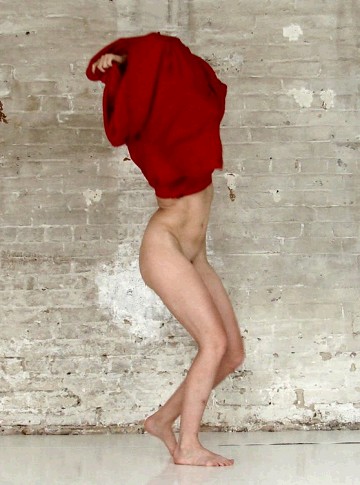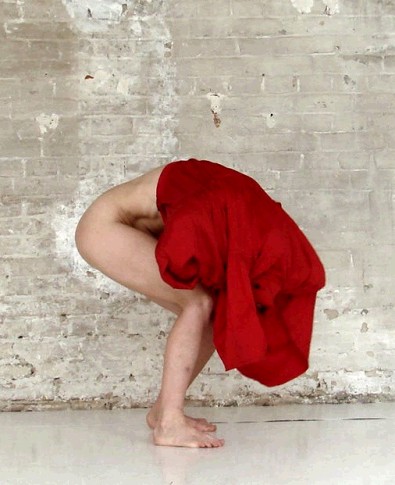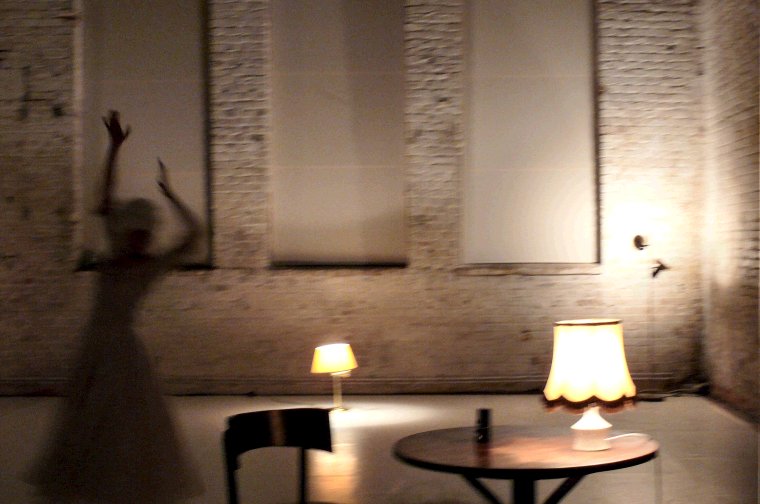Ines Birkhan: Schmetterlinge, Sex & Hypochondrie
Dock11 in Berlin, August 2007
Photos by courtesy of Real Dance Super Sentai


Birkhan's "Butterflies, Sex & Hypochondria" is a body-centered spectacle, charged on the surface and substantial in the depth. One of those amazing choreographies surfacing in the off-scene that make you think wow, this should run in a theatre with hundreds of seats for a whole season. Until you soberly realize that it would not work, as established art sanctuaries are unapt for these delicacies. Off-scene is not perfect, but it is the place where the progress in stage performance comes from.
The opening of the piece is smashing. Ines Birkhan is sitting on a chair with her lower body naked, raised hands holding a ball of fabric which completely covers her arms, head and shoulders and ends just below her breasts. Absolute silence. She stands up and starts moving, balancing the voluminous cloth on the top of her muscular body. One leg, bent in the knee, sticks to the ground while the other, stretched backwards, slowly turns around, dragging the body in a circle. In small, tentative steps the dancer's lower body steers for a destination, carefully but determined. The body descends a few inches and rises again, adjusting its position. After a while, the dancer faces the audience with her back. Her feet stay far apart while the turning leg accomplishes a cycle, closing the buttocks and twisting the body. The strong image is a hard reality for the dancer. She cannot breathe well with her head wrapped in the heavy cloth and also does not see much, can barely recognize the light shimmering through the fabric. It is not just the physical hardness: inability to see those who are watching you when you are exposed naked aggravates your discomfort. Performers are very special people. This piece is also a challenge for the spectators, even if they are familiar with stage nakedness, because they cannot control the focus: there is no face, hair or shoulders to rest your eyes upon. Nothing but a slowly moving lower body.
Eventually the dancer releases the fabric from her hands. It turns out to be a long, white Victorian dress. Falling down along the body, it covers her nakedness and exposes her identity. Because she wears a white, medieval wig, the face appears unreal like on a painting. The abrupt change to a puritan image is drastic and Ines Birkhan is going to switch back and forth again, as it is one of her major tools.

There is no music or words in the whole performance. The only audible sound is the clicking of two metronomes, which Birkhan uses in the middle part of the piece, in an intermezzo when she lets the audience take a breath before she tightens her grip again.
What do butterflies, sex and hypochondria mean? Ines Birkhan told me that she tried to blend all three sources of inspiration into each scene. I could recognize them here and there, but the middle one clearly dominates. With little changes and shorter by one or two scenes, the piece could exist without butterflies or without hypochondria, but nothing would remain if you took out the sex. Sensuality and desire are shown in different facets. The contrast between a puritan image, made up by a white dress and a nobility wig, with the voluptuousness of the dancer's lower body is just one of them. (When you watch the photos on the top, think of the red color as white. The photos, kindly provided by Real Dance Super Sentai, were taken with Ines Birkhan wearing a red dress.) Switching between the two sorts of images is a recurrent topic. The dancer flashes her dress while jumping into the air and exposes her buttocks while crawling on all fours. These gags provoke laughter, but as the piece progresses, the lust gets tainted by restraint, guilt or even self-punishment.
The Victorian dress looks ordinary when you watch Birkhan standing, but it is specially modified by cutting the back part up to the waist. The purpose is that the dancer can bare her legs while crawling and squeeze the fabric between her thighs while she presses her buttock on the wall at the back of the stage. This is an utterly odd posture: Sie pushes her dress between her legs, which are stretched straight and wide apart, and slowly starts sliding forwards on her heels. Only her heels and bare buttock are touching the support, feet keeping a right angle to lower legs. She might be flying, and indeed she raises her arms and stretches them towards the audience, with flat palms directed towards the floor. Her arms are balancing like during a ski jump or on a high-speed sleigh. It is not a flight, but it feels like that. You think you can hear a high-pitched sound, but the room is absolutely silent. Try to visualize it.
In her blog, Ines Birkhan explained that the piece was about "how social repression of physicality can be opposed through performance in a programmatic way". To me, the repression of physicality appeared self-inflicted. Disenchantment and self-repression gained the upper hand as the piece developed. This is how I read the sequel of the five or six scenes, beginning with the body searching for a destination, followed by a pursuit of joy which gradually grew aggressive and eventually turned into violence directed towards itself. In the final scene, the dancer repeatedly takes the symbolic pose: standing on one leg, she lifts her dress so that the other leg can hit the knee or thigh with its flat foot. It remains there, braced against the leg, being released only to hit and press again, stronger and stronger. The body is frozen in a stiff position, bringing a quest for joy to its end.
"Butterflies, Sex & Hypochondria" is an extraordinary performance, touching and disturbing alike by its personal reference and its artistic encoding into compelling bodily images. It is one of those pieces that let you forget about esthetics and structure, leaving you with what art is for - perceiving, recepting and apprehending.

Text and the last two photos by Petr Karlovsky